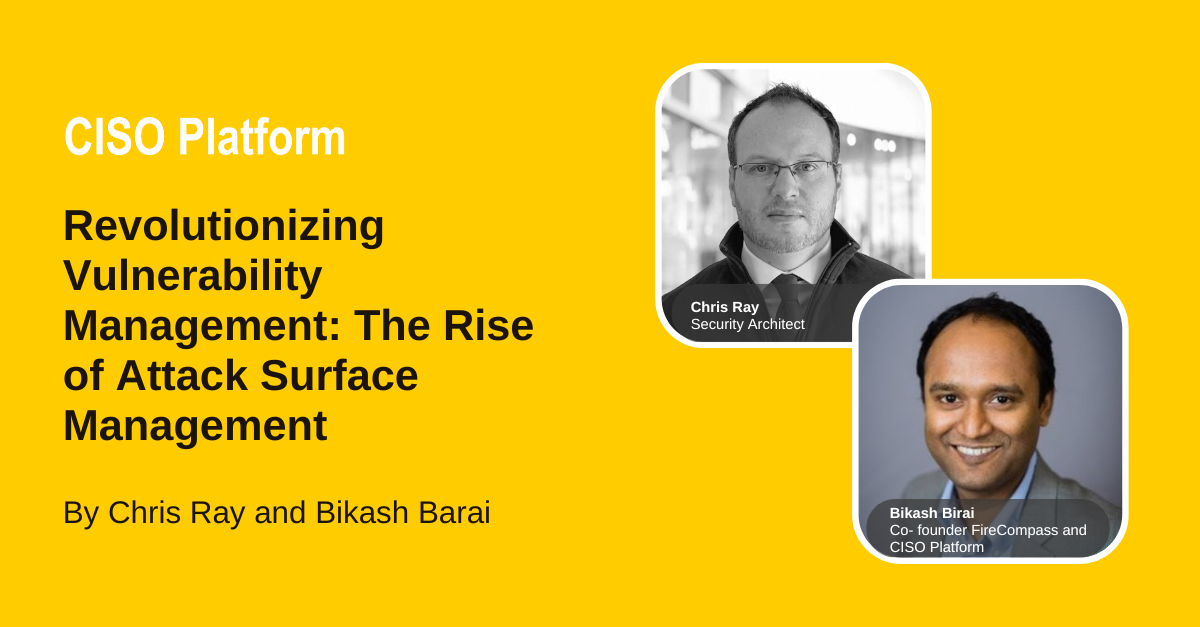In the realm of cybersecurity, the landscape is constantly evolving, presenting new challenges and opportunities for organizations. One such challenge lies in effectively managing vulnerabilities across diverse and dynamic digital environments. Traditional vulnerability scanning solutions, while useful, often fall short when it comes to providing comprehensive visibility into an organization's attack surface. In this blog, we explore the shortcomings of legacy vulnerability management and the transformative potential of Attack Surface Management (ASM) in revolutionizing how organizations approach vulnerability management.
Here is the verbatim discussion:
There's a handful of them the Legacy vulnerability scanning Solutions require that you know your IP space roughly even if it's an IP block you could say here's my slash21 on the Internet or whatever it is my slash28 just keep scanning it and tell me what's there but what if you have assets that fall outside of the gnome well the Legacy vulnerability scanners are going to completely fail they have zero insight into what's there and that's that's a major problem for a lot of organizations attack surface what's the future like yeah and you know the the example of Legacy vulnerability management shows you what's broken it's it's noisy produces a lot of findings that are low confidence ASM can't do what that is doing it it it'll fail so ASM even though it discovers even more assets more broadly more comprehensively um through two methods of interaction with those remote assets either passive which is similar not the same but similar as the Legacy vulnerability management or active assessments meaning assets been identified okay now let's kick off some programmatic thing that's going to go out and interact with the asset and observe its behaviors does it respond with a SSL an SSH login does it give me back a banner um if I know that this asset in the app version that's running on it is vulnerable to a remote code execution maybe it's possible through Act assessments to run a benign version of that attack and you can then measure the results that's a very specific example but some ASM Solutions are able to go out and do that so now what you end up with is instead of Legacy vulnerability management with 20% confidence that this is the vulnerability on the other end of the wire, you have ASM, Which is like 100% confident this is the vulnerability on the other end of the wire.
Highlights:
Limitations of Legacy Vulnerability Management: Legacy vulnerability scanning solutions are often limited by their reliance on predefined IP ranges or blocks. This approach fails to account for assets that fall outside of these predefined boundaries, resulting in blind spots and incomplete assessments of an organization's attack surface. Moreover, legacy solutions tend to produce noisy findings with low confidence, making it challenging for security teams to prioritize and remediate vulnerabilities effectively.
The Promise of Attack Surface Management: ASM represents a paradigm shift in vulnerability management, offering a more comprehensive and proactive approach to identifying and mitigating security risks. Unlike legacy solutions, ASM leverages both passive and active assessment methods to discover assets and assess their vulnerabilities. Passive assessments provide insights into the presence of assets, while active assessments allow for deeper analysis of vulnerabilities, including the ability to simulate attacks and measure their impact.
Enhanced Confidence and Accuracy: By combining passive and active assessment techniques, ASM provides organizations with a higher level of confidence and accuracy in identifying vulnerabilities. Rather than relying on noisy findings with low confidence levels, ASM delivers precise insights into the vulnerabilities present on an organization's network. This increased accuracy enables security teams to prioritize remediation efforts more effectively, reducing the overall risk exposure.
As organizations grapple with the ever-expanding threat landscape, the need for robust vulnerability management solutions has never been more critical. Legacy vulnerability scanning solutions, while valuable, are no longer sufficient in providing the level of visibility and accuracy required to mitigate modern security risks. Attack Surface Management emerges as a transformative solution, offering a proactive and comprehensive approach to vulnerability management. By embracing ASM, organizations can gain a deeper understanding of their attack surface, prioritize remediation efforts more effectively, and ultimately enhance their overall security posture. As we continue to navigate the evolving cybersecurity landscape, ASM stands poised to revolutionize how organizations manage vulnerabilities, ensuring a more secure and resilient future.
Chris Ray, a seasoned professional in the cybersecurity field, brings a wealth of experience from small teams to large financial institutions, as well as industries such as healthcare, financials, and tech. He has acquired an extensive amount of experience advising and consulting with security vendors, helping them find product-market fit as well as deliver cyber security services.
Bikash Barai is credited for several innovations in the domain of Network Security and Anti-Spam Technologies and has multiple patents in USPTO. Fortune recognized Bikash among India’s Top 40 Business Leaders under the age of 40 (Fortune 40-under-40).Bikash is also an active speaker and has spoken at various forums like TiE, RSA Conference USA, TEDx etc.
Earlier he founded iViZ an IDG Ventures-backed company that was later acquired by Cigital and now Synopsys. iViZ was the first company in the world to take Ethical Hacking (or Penetration Testing) to
the cloud.


Comments